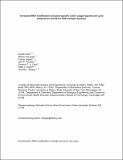| dc.contributor.author | Patil, Ashish | |
| dc.contributor.author | Dyavaiah, Madhu | |
| dc.contributor.author | Joseph, Fraulin | |
| dc.contributor.author | Rooney, John P. | |
| dc.contributor.author | Chan, Tsz Yan Clement | |
| dc.contributor.author | Dedon, Peter C. | |
| dc.contributor.author | Begley, Thomas J. | |
| dc.date.accessioned | 2014-10-29T20:04:36Z | |
| dc.date.available | 2014-10-29T20:04:36Z | |
| dc.date.issued | 2014-10 | |
| dc.date.submitted | 2012-08 | |
| dc.identifier.issn | 1538-4101 | |
| dc.identifier.issn | 1551-4005 | |
| dc.identifier.uri | http://hdl.handle.net/1721.1/91232 | |
| dc.description.abstract | S-phase and DNA damage promote increased ribonucleotide reductase (RNR) activity. Translation of RNR1 has been linked to the wobble uridine modifying enzyme tRNA methyltransferase 9 (Trm9). We predicted that changes in tRNA modification would translationally regulate RNR1 after DNA damage to promote cell cycle progression. In support, we demonstrate that the Trm9-dependent tRNA modification 5-methoxycarbonylmethyluridine (mcm⁵U) is increased in hydroxyurea (HU)-induced S-phase cells, relative to G₁ and G₂, and that mcm⁵U is one of 16 tRNA modifications whose levels oscillate during the cell cycle. Codon-reporter data matches the mcm⁵U increase to Trm9 and the efficient translation of AGA codons and RNR1. Further, we show that in trm9Δ cells reduced Rnr1 protein levels cause delayed transition into S-phase after damage. Codon re-engineering of RNR1 increased the number of trm9Δ cells that have transitioned into S-phase 1 h after DNA damage and that have increased Rnr1 protein levels, similar to that of wild-type cells expressing native RNR1. Our data supports a model in which codon usage and tRNA modification are regulatory components of the DNA damage response, with both playing vital roles in cell cycle progression. | en_US |
| dc.description.sponsorship | National Institute of Environmental Health Sciences (R01 ES015037) | en_US |
| dc.description.sponsorship | National Institute of Environmental Health Sciences (R01 ES017010) | en_US |
| dc.description.sponsorship | National Institute of Environmental Health Sciences (P30 ES002109) | en_US |
| dc.description.sponsorship | Massachusetts Institute of Technology (Westaway Fund) | en_US |
| dc.description.sponsorship | Singapore-MIT Alliance for Research and Technology | en_US |
| dc.language.iso | en_US | |
| dc.publisher | Taylor & Francis | en_US |
| dc.relation.isversionof | http://dx.doi.org/10.4161/cc.21919 | en_US |
| dc.rights | Creative Commons Attribution-Noncommercial-Share Alike | en_US |
| dc.rights.uri | http://creativecommons.org/licenses/by-nc-sa/4.0/ | en_US |
| dc.source | Prof. Dedon via Howard Sliver | en_US |
| dc.title | Increased tRNA modification and gene-specific codon usage regulate cell cycle progression during the DNA damage response | en_US |
| dc.type | Article | en_US |
| dc.identifier.citation | Patil, Ashish, Madhu Dyavaiah, Fraulin Joseph, John P. Rooney, Clement T.Y. Chan, Peter C. Dedon, and Thomas J. Begley. “Increased tRNA Modification and Gene-Specific Codon Usage Regulate Cell Cycle Progression During the DNA Damage Response.” Cell Cycle 11, no. 19 (October 1, 2012): 3656–3665. | en_US |
| dc.contributor.department | Massachusetts Institute of Technology. Center for Environmental Health Sciences | en_US |
| dc.contributor.department | Massachusetts Institute of Technology. Department of Biological Engineering | en_US |
| dc.contributor.department | Massachusetts Institute of Technology. Department of Chemistry | en_US |
| dc.contributor.approver | Dedon, Peter C. | en_US |
| dc.contributor.mitauthor | Chan, Tsz Yan Clement | en_US |
| dc.contributor.mitauthor | Dedon, Peter C. | en_US |
| dc.relation.journal | Cell Cycle | en_US |
| dc.eprint.version | Author's final manuscript | en_US |
| dc.type.uri | http://purl.org/eprint/type/JournalArticle | en_US |
| eprint.status | http://purl.org/eprint/status/PeerReviewed | en_US |
| dspace.orderedauthors | Patil, Ashish; Dyavaiah, Madhu; Joseph, Fraulin; Rooney, John P.; Chan, Clement T. Y.; Dedon, Peter C.; Begley, Thomas J. | en_US |
| dc.identifier.orcid | https://orcid.org/0000-0003-0011-3067 | |
| dc.identifier.orcid | https://orcid.org/0000-0001-7940-3459 | |
| dspace.mitauthor.error | true | |
| mit.license | OPEN_ACCESS_POLICY | en_US |
| mit.metadata.status | Complete | |
